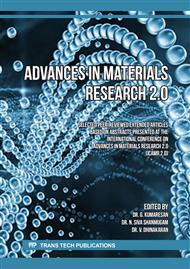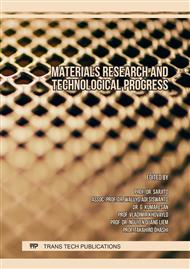[1]
S. Abdulkareem, A. Ali Khan, and M. Konneh, Cooling effect on electrode and process parameters in EDM,, Mater. Manuf. Process., vol. 25, no. 6, p.462–466, (2010).
DOI: 10.1080/15394450902996619
Google Scholar
[2]
M. Dhananchezian, M. P. Kumar, and T. Sornakumar, Cryogenic turning of AISI 304 stainless steel with modified tungsten carbide tool inserts,, Mater. Manuf. Process., vol. 26, no. 5, p.781–785, (2011).
DOI: 10.1080/10426911003720821
Google Scholar
[3]
Z. Hui, Z. Liu, Z. Cao, and M. Qiu, Effect of cryogenic cooling of tool electrode on machining titanium alloy (Ti–6Al–4V) during EDM,, Mater. Manuf. Process., vol. 31, no. 4, p.475–482, (2016).
DOI: 10.1080/10426914.2015.1037893
Google Scholar
[4]
M. Vijayakumar, S. R. Ambadi, P. Selvakumar, and P. Mathan, An analysis of household refrigerator using Polyester–Aluminum oxide Nano lubrication,, Mater. Today Proc., (2021).
DOI: 10.1016/j.matpr.2021.04.377
Google Scholar
[5]
M. Vijayakumar, B. S. Swaroop, S. Mareeswaran, and N. Gnanakumar, Feature of dry wear using aluminum depend on metal mixture compounds,, Mater. Today Proc., (2021).
DOI: 10.1016/j.matpr.2021.04.388
Google Scholar
[6]
R. Goyal, S. Sngh, and H. Kumar, Performance evaluation of cryogenically assisted electric discharge machining (CEDM) process,, Mater. Manuf. Process., vol. 33, no. 4, p.433–443, (2018).
DOI: 10.1080/10426914.2017.1317789
Google Scholar
[7]
S. S. Habib, Study of the parameters in electrical discharge machining through response surface methodology approach,, Appl. Math. Model., vol. 33, no. 12, p.4397–4407, (2009).
DOI: 10.1016/j.apm.2009.03.021
Google Scholar
[8]
Y. Yildiz and M. Nalbant, A review of cryogenic cooling in machining processes,, Int. J. Mach. Tools Manuf., vol. 48, no. 9, p.947–964, (2008).
DOI: 10.1016/j.ijmachtools.2008.01.008
Google Scholar
[9]
J. Y. Huang, Y. T. Zhu, X. Z. Liao, I. J. Beyerlein, M. A. Bourke, and T. E. Mitchell, Microstructure of cryogenic treated M2 tool steel,, Mater. Sci. Eng. A, vol. 339, no. 1–2, p.241–244, (2003).
DOI: 10.1016/s0921-5093(02)00165-x
Google Scholar
[10]
N. S. Kalsi, R. Sehgal, and V. S. Sharma, Cryogenic treatment of tool materials: a review,, Mater. Manuf. Process., vol. 25, no. 10, p.1077–1100, (2010).
DOI: 10.1080/10426911003720862
Google Scholar
[11]
V. Srivastava and P. M. Pandey, Experimental investigation on electrical discharge machining process with ultrasonic-assisted cryogenically cooled electrode,, Proc. Inst. Mech. Eng. Part B J. Eng. Manuf., vol. 227, no. 2, p.301–314, (2013).
DOI: 10.1177/0954405412469487
Google Scholar
[12]
J. Kapoor, S. Singh, and J. S. Khamba, Effect of cryogenic treated brass wire electrode on material removal rate in wire electrical discharge machining,, Proc. Inst. Mech. Eng. Part C J. Mech. Eng. Sci., vol. 226, no. 11, p.2750–2758, (2012).
DOI: 10.1177/0954406212438804
Google Scholar
[13]
A. Kumar, S. Maheshwari, C. Sharma, and N. Beri, Machining efficiency evaluation of cryogenically treated copper electrode in additive mixed EDM,, Mater. Manuf. Process., vol. 27, no. 10, p.1051–1058, (2012).
DOI: 10.1080/10426914.2011.654151
Google Scholar
[14]
R. K. Bhuyan, B. C. Routara, A. K. Parida, and A. K. Sahoo, Parametric optimization of Al-SiC12% metal matrix composite machining by Electrical discharge machine,, in India manufacturing technology design and research conference, 2014, p.345.
Google Scholar
[15]
S. Kumar, A. Batish, R. Singh, and T. P. Singh, A mathematical model to predict material removal rate during electric discharge machining of cryogenically treated titanium alloys,, Proc. Inst. Mech. Eng. Part B J. Eng. Manuf., vol. 229, no. 2, p.214–228, (2015).
DOI: 10.1177/0954405414527955
Google Scholar
[16]
S. Abdulkareem, A. A. Khan, and M. Konneh, Reducing electrode wear ratio using cryogenic cooling during electrical discharge machining,, Int. J. Adv. Manuf. Technol., vol. 45, no. 11, p.1146–1151, (2009).
DOI: 10.1007/s00170-009-2060-5
Google Scholar
[17]
R. Singh and B. Singh, Comparison of cryo-treatment effect on machining characteristics of titanium in electric discharge machining,, Int. J. Automot. Mech. Eng., vol. 3, p.239–248, (2011).
DOI: 10.15282/ijame.3.2011.1.0020
Google Scholar
[18]
V. Srivastava and P. M. Pandey, Performance evaluation of electrical discharge machining (EDM) process using cryogenically cooled electrode,, Mater. Manuf. Process., vol. 27, no. 6, p.683–688, (2012).
DOI: 10.1080/10426914.2011.602790
Google Scholar
[19]
V. Kumar. S and P. Kumar. M, Optimization of cryogenic cooled EDM process parameters using grey relational analysis,, J. Mech. Sci. Technol., vol. 28, p.3777–3784, (2014).
DOI: 10.1007/s12206-014-0840-9
Google Scholar
[20]
P. B. Singh, G. S. Phull, and S. Puggal, STUDY OF RADIAL OVERCUT DURING EDM OF H-13 STEEL WITH CRYOGENIC COOLED ELECTRODE USING TAGUCHI METHOD,, Int. J. Mech. Eng. Robot. Res., vol. 4, no. 1, p.33, (2015).
Google Scholar
[21]
S. Shamsudin and M. Yusof, Electrical Discharge Machining (EDM) Of Beryllium Copper Alloys Using Design Of Experiment (Doe) Approach,, in International Engineering Convention, Damascus Syria, 2009, vol. 11, p.257–268.
Google Scholar
[22]
S. V. Kumar and M. P. Kumar, Machining process parameter and surface integrity in conventional EDM and cryogenic EDM of Al–SiCp MMC,, J. Manuf. Process., vol. 20, p.70–78, (2015).
DOI: 10.1016/j.jmapro.2015.07.007
Google Scholar



